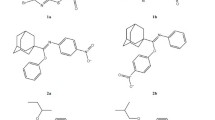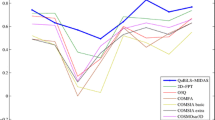Abstract
This study describes the use of alignment-independent descriptors for obtaining qualitative and quantitative predictions of the competitive inhibition of CYP2C9 on a serie of highly structurally diverse compounds. This was accomplished by calculating alignment independent descriptors in ALMOND. These GRid INdependent Descriptors (GRIND) represent the most important GRID-interactions as a function of the distance instead of the actual position of each grid-point. The experimental data was determined under uniform conditions. The inhibitor data set consists of 35 structurally diverse competitive stereospecific inhibitors of the cytochrome P450 2C9 and the non -inhibitor data set of 46 compounds. In a PLS discriminant analysis 21 inhibitors and 21 non-inhibitors (1 and 0 as activities) were analyzed using the ALMOND program obtaining a model with an r 2 of 0.74 and a cross-validation value (q 2) of 0.64. The model was externally validated with 39 compounds (14 inhibitors/25 non-inhibitors). 74% of the compounds were correctly predicted and an additional 13% was assigned to a borderline cluster. Thereafter, a model for quantitative predictions was generated by a PLS analysis of the GRIND descriptors using the experimental Ki-value for 21 of the competitive inhibitors (r 2=0.77, q 2=0.60). The model was externally validated using 12 compounds and predicted 11 out of 12 of the Ki-values within 0.5 log units. The discriminant model will be useful in screening for CYP2C9 inhibitors from large compound collections. The 3D-QSAR model will be used during lead optimization to avoid chemistry that result in inhibition of CYP2C9.
Similar content being viewed by others
References
Stockman, B.J., et al., FEBS Lett., 283 (1991) 267–269.
Schaal, W., et al., J. Med. Chem., 44 (2001) 155–169.
Martin, Y.C., et al., J. Comput-Aided Mol. Design, 7(1992) 83–102.
CATALYST, Molecular Simulations: San Diego, CA.
Ekins, S., et al., J. Pharmacol. Exp. Ther., 288 (1999) 21–29.
Ekins, S., M.J. de Groot, and J.P. Jones, Drug Metab. Dis., 29 (2001) 936–944.
Jones, J.P., et al., Drug Metab. Dis., 24(1996) 1–6.
Afzelius, L., et al., Mol. Pharmacol., 59 (2001) 909–919.
Goodford, P.J., J. Med. Chem., 28 (1985) 849–857.
Cramer, R.D.r., D.E. Patterson, and J.D. Bunce, J. Am. Chem. Soc., 110 (1988) 5959–5967.
Pastor, M., et al., J. Med. Chem., 43 (2000) 3233–3243.
Riganelli, D., et al., Pharm. Pharmacol. Lett., 3 (1993) 5–8.
Smith, D.A., M.J. Ackland, and B.C. Jones, Drug Discovery Today, 2 (1997) 406–414.
Murray, M., Int. J. Mol. Med., 3 (1999) 227–238.
Rendic, S. and F.J. Di Carlo, Drug Metab. Rev., 29 (1997) 413–580.
Masimirembwa, C.M., et al., Meth. Enzymol., (2001) submitted.
Smith, D.A., M.J. Ackland, and B.C. Jones, Drug Discovery Today, 2 (1997) 479–485.
Sjöström, M., S. Wold, and B. Söderström. Proc. PARC in Practice, (1985) North-Holland.
Wold, S., et al., Chemometrics: Mathematics and Statistics in Chemistry, K.B. R, Editor. 1984, Reidel Publishing Company, Holland: Dordrecht.
Bardsley, W.G., et al., Comput. Chem., 19 (1995) 75–)84.
Masimirembwa, C.M., et al., Drug Metabol. Dis., 27 (1999) 1117–1122.
Wold, S., K. Esbensen, and P. Geladi, Chem. Intell. Lab. Syst., 2 (1987) 37–52.
Oprea, T.I. and J. Gottfries, J. Combin. Chem., 3(2001) 157–166.
Olsson, T. and V. Shcherbukhin, Synthesis and Structure Administration (SaSA). 1997-2000, AstraZeneca, http://www.astrazeneca.com.
Cruciani, G., M. Pastor, and W. Guba, Eur. J. Pharmaceut. Sci., 11 (2000) S29–39.
Miners, J.O. and D.J. Birkett, B. J. Clin. Pharmacol., 45 (1998) 525–538.
Rao, S., et al., J. Med. Chem., 43 (2000) 2789–2796.
Cruciani, G. and K.A. Watson, J. Med. Chem., 37 (1994) 2589–2601.
Baroni, M., et al., Quantit. Struct. Act. Rel., 12 (1993) 225–231.
Fedorov, V.V., Theory of Optimal Experiments. 1972, New York: Academic Press.
Albano, C., et al., Anal. Chim. Acta, 103 (1978) 429–443.
Cruciani, G., et al., Predictive Ability of Regression Models. Part I: Standard Deviation of Predicion Errors (SDEP). Journal of Chemometrics, 1992. 6: p. 335–346.
Box, G.E.P., W.G. Hunter, and S.J. Hunter, Statistics for experimenters. 1978: John Wiley.
Baroni, M., et al., Quantit. Struct. Act. Rel., 12 (1993) 9–20.
Zamora, I., T.I. Oprea, and A.L. Ungell, J. Med. Chem., (2001) submitted.
Hansch, C., Drug Metab. Rev., 1 (1972) 1–14.
Baroni, M., et al., Quantit. Struct. Act. Rel., 12 (1993) 9–20.
Miners, J.O., et al., Biochem. Pharmacol., 37 (1988) 1137–1144.
Author information
Authors and Affiliations
Corresponding author
Rights and permissions
About this article
Cite this article
Afzelius, L., Masimirembwa, C.M., Karlén, A. et al. Discriminant and quantitative PLS analysis of competitive CYP2C9 inhibitors versus non-inhibitors using alignment independent GRIND descriptors. J Comput Aided Mol Des 16, 443–458 (2002). https://doi.org/10.1023/A:1021281008423
Issue Date:
DOI: https://doi.org/10.1023/A:1021281008423




